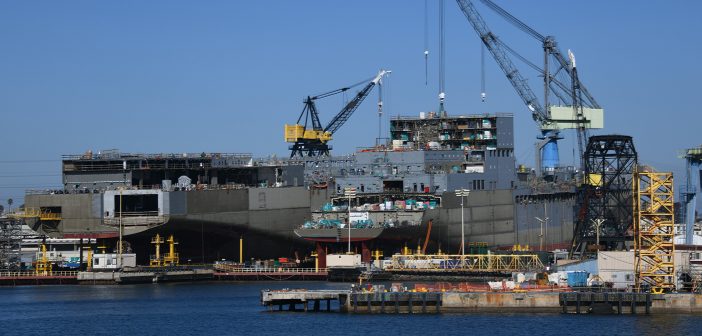James “Hondo” Geurts, top acquisition official for the US Navy and Marine Corps, is working to coordinate government and industry efforts to keep the nation’s industrial base healthy and functioning during the coronavirus pandemic.
“We are taking both the short term and the long term view,” Geurts told reporters March 25 on a conference call. “We’re trying to mitigate risk where we can and also ensure some of the longer-term programs such as the Columbia [ballistic submarine program]do not get disrupted, or minimize the disruption as best we can.
“This is about balance, leveraging the skills and mindset, and about communicating clearly with everybody as we continue to adjust and overcome challenges as they pop up.”
Geurts praised industry and government managers for their willingness to work together and share best practices in dealing with the outbreak and its effects. He repeatedly emphasized the need to worry about not only the major prime contractors, but also second- and third-tier suppliers.
“I’ve communicated directly at the CEO level that things we do at the prime contractor level, I’m getting their commitment this will flow down to lower levels,” Geurts said. “I’m very concerned about some of our suppliers who will feel the pinch faster.”
Among the challenges are the different levels of the outbreak in different regions of the country, coupled with varying state and local responses and requirements. There is no one-size-fits-all approach, Geurts acknowledged.
“We’re going to have to partner closely and figure out what works best in each particular situation,” he said.
“We’re seeing a tightening on the supply base as smaller shops deal with their local situations. In the major industrial operations it’s site-dependent. I think you’ll see some disruption. We’re keeping a close eye on that. We’re trying to understand what delays are due to the disruption.
“What I am not slowing down is on the demand side. In fact [we’re] accelerating in ensuring economic wellness. We’re not slowing down what we planned to award – we’re getting that demand signal in to ensure that as folks come back to work there’s work for them.”
Examples of recent contract awards that were announced somewhat sooner than planned, Geurts said, include a $130 million award to Gulf Island Shipyards for two more towing, salvage and rescue ships; a $40 million award to VT Halter Marine for an auxiliary personnel lighter; and a $392 million award to Raytheon Missile Systems for AIM-9X missiles.
With the defense industrial base having been declared by the federal government to be a critical infrastructure, employees continue to come to work even in areas where most business are shuttered. Companies are coming up with varying approaches to deal with disruptions from higher-than-normal outages of employees on the sick list.
“The real issue is going back to balance and best practices,” Geurts said. “For instance you can spread out the work over multiple ships. Some companies are doing that to reduce the risk of [person-to-person] contact, splitting up into different shifts, modifying how work is done in a module.
“We have similar challenges across the industrial base,” Geurts noted. “What I’m trying to do mostly is sharing those practices. But we also have to make sure we’ve got economic wellness in our defense industrial base. We need to keep folks safe but we also have to ensure we’ve got the work lined up so we don’t have a healthy work force with [work disruptions].”
In an era of fixed-price contracts with added attention to keeping on schedule, Geurts acknowledged it will be difficult for the Navy to judge contract performance with all the disruptions.
“We’re baselining contracts pre-virus so we understand performance post-virus,” he said. “That will allow us to work through that.”
Judging contract performance will have to be on a case-by-case basis, Geurts said.
“On the penalty side we’ll work through understanding those and how to deal with those. My promise to industry is we’ll try and work those things and try to come to a common understanding of [before and after]the virus.
“It’s a little premature to have a blanket yes and no. We’ll have to look at each one of those. My goal I’ve demanded from my team is the fair and reasonable principal. We’ll work as quickly as we can to resolve those issues.”
Geurts said he is working under three operating concerns: the physical health of the work force, the economic wellness of the defense industrial base, and the warfighting readiness of the Navy and Marine Corps.
“I’m going to stay focused on the three lines of communication I outlined,” he said. “First and foremost is the health of the industrial work force, and that’s all the way from government to our large primes [contractors]and industrial operations all the way down to our small suppliers. Making sure our guidelines get out clearly and that we work to adjust work as best we can given that health and wellness in mind.
“Second will be the economic wellness of the defense industrial base. Accelerating payments, moving up contractor awards, solidifying commitments. All of that so that as the work force adjusts and continues to come back to full speed in areas or has to adjust to delays in others the work is there for them and we can continue to move firmly. And ensuring this is not just at the prime contractor level but all the way through the supplier base.
“And third, through those first two lines of operation, ensuring we have the readiness for our Navy and Marine Corps team.”
Geurts and several industry sources said that to date, there are no significant reported delays to shipbuilding or aircraft production.
Huntington Ingalls Industries, the nation’s largest shipbuilder, continues its main operations at Newport News, Virginia and Pascagoula, Mississippi.
“At HII we are taking actions that are designed with the health and safety of our employees at the forefront of our decision making, and this extends across the enterprise,” HII spokesperson Beci Brenton said in an e-mail. “These include but are not limited to extending liberal leave, teleworking where feasible, alternate work schedules, social distancing and extensive cleaning in our facilities.
“Regarding impacts to shipbuilding schedules, it is premature to speculate on the impact of COVID-19 on our contracts. We are having ongoing discussions with our customers and suppliers and will continue that dialogue in preparing contingencies and future plans,” Brenton added.
HII so far has reported at least six employees have tested positive for the COVID-19 virus, three in Newport News and three in Pascagoula.
“We’re really stepping up the cleaning,” Brenton said. Maintaining social distance, wiping down turnstiles. We’re functioning the yards the best we can where there are restrictions. We haven’t had to face a shelter-in-place situation.”
Production is continuing at the three shipbuilding businesses of General Dynamics.
At the GD Electric Boat shipyards in Groton, Connecticut and Quonset Point, Rhode Island, president Kevin Graney told employees March 26 there were no reported positive tests of the COVID-19 virus among shipyard workers.
GD’s Bath Iron Works shipyard in Bath, Maine reported at least one employee tested positive as of early March 26. Employees at the shipyard have been especially disgruntled on the company’s Facebook page about continuing to work in close proximity.
In San Diego Dave Carver, head of the GD NASSCO shipyard, recognized in a March 25 memo to employees that “practicing social distancing in the shipyard is easy for some but not easy for everybody.” As a result, all employees in the shipyard’s new construction and repair operations are being required “to wear a respirator, mask or other type of barrier such as a neck gaiter in order to prevent particles from our mouths becoming airborne.”
The company had not reported any positive virus tests as of early March 26.
E-mail chriscavas@gmail.com




